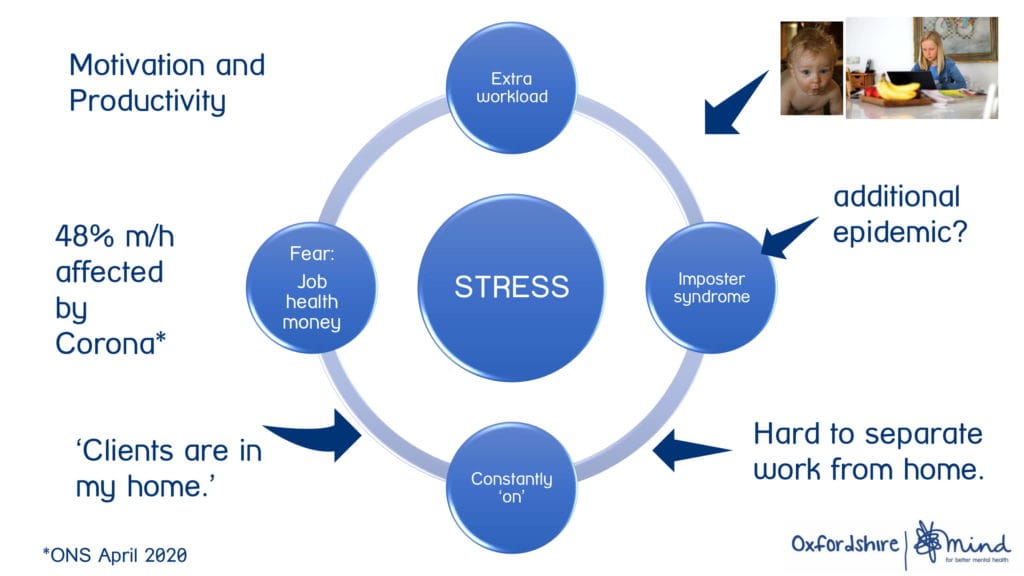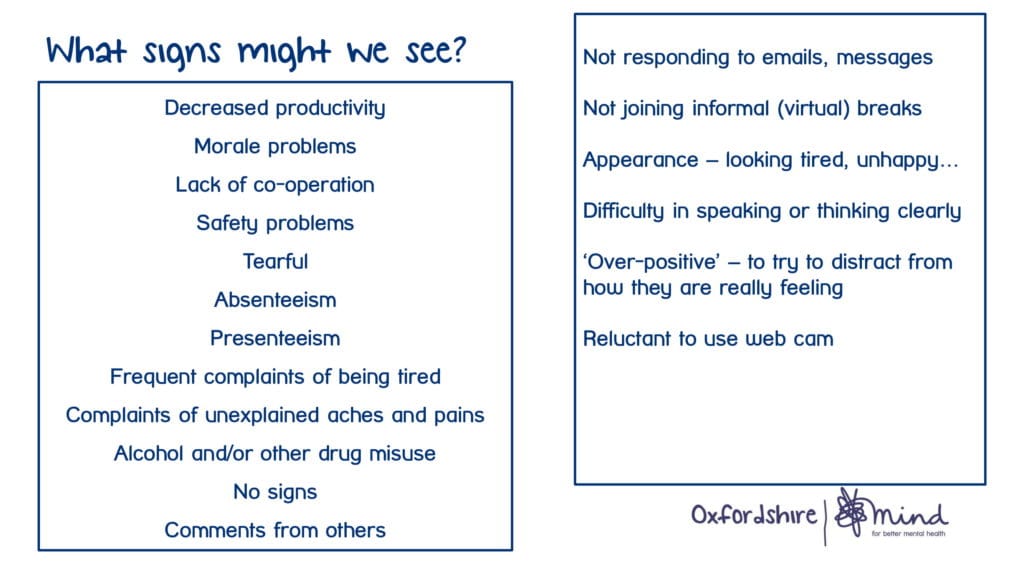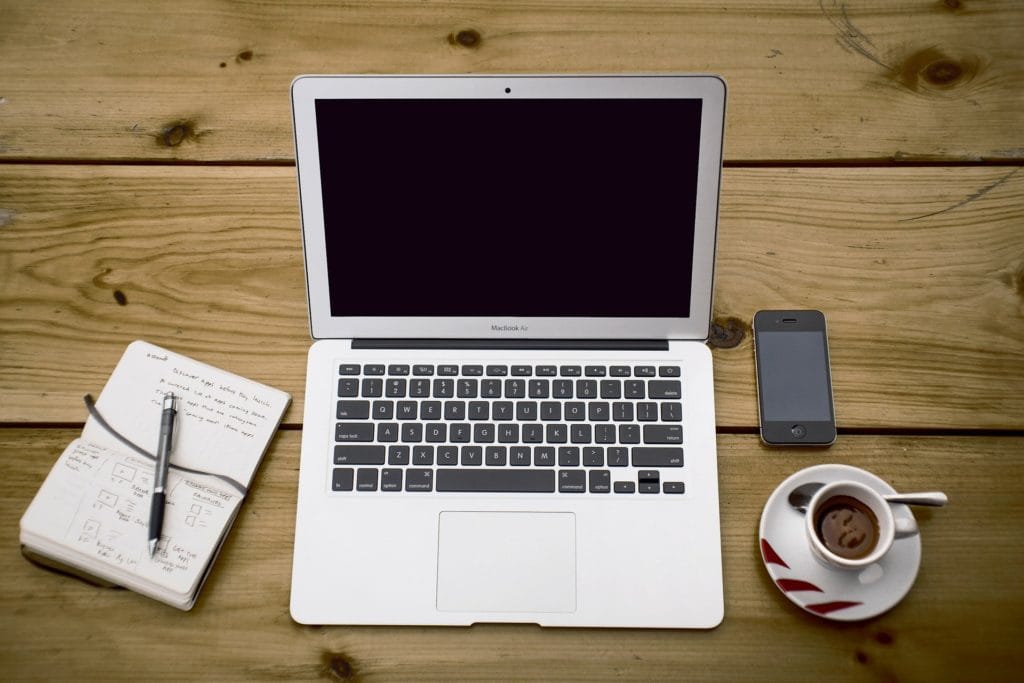Practical advice on dealing with Mental Health and Wellbeing in the Workplace.
Homeworking has been a positive experience for many people: more time with their families; more flexibility; more time spent outdoors; fewer commutes.
However, in a report by Allen Associates to better understand the HR impact of Covid-19 on Oxfordshire businesses, over half (56%) of HR decision-makers surveyed said that dealing with staff mental health and wellbeing was their biggest challenge brought about by homeworking.
This is borne out by my own experiences. During my recent consultations and training deliveries I have become aware of a number of concerns that are contributing to increased stress levels and impacting on people’s wellbeing.
Many workers are working from bedsits, bedrooms, kitchens and living rooms. Work has entered and impacted private spaces that they may have previously relaxed in. This has serious implications for our mental and physical health and is linked to increased stress levels, also impacted by the following factors:

- ‘Invasion’
People have described work ‘invading’ their homes. One homeworker told me of a very difficult phone conversation with a client. The worker explained that after the phone call, it felt like the ‘client was in my home’. They found this distressing and struggled to disperse the feeling. For some, this repeats daily as they absorb the stresses and frustrations of customers, with no colleagues at their side to off-load to and no commuting time to allow them to process the day’s experiences. Working in isolation tends to intensify difficult feelings for workers.
I am seeing evidence of workers being constantly ‘on’, with no backstage to retreat to, physically or mentally. The top-scoring concern in every poll that I cast during my online training sessions is ‘feeling unable to separate work from home’. In addition to the kind of scenario mentioned above, people are working beyond healthy hours, forgetting to take breaks, checking emails in the evenings and at weekends. It is so tempting when the equipment is always visible. Where does work end and home begin?
Add into the mix childcare; health, job and money worries; increased workload and the feeling that everyone else is doing better than you (a new epidemic of Imposter Syndrome). We risk a rise in stress and anxiety and a drop in motivation and productivity.
There is concern also for furloughed staff. The uncertainty and fear that many experience, along with misunderstandings about their situation are summed up here: “I don’t feel like I’m on holiday at all. I need a purpose to my days. It is much harder for us than people realise.”
According to the Office of National Statistics, in April 48% of workers reported that their mental health had been affected by the pandemic. I’m curious as to whether this figure has changed since then.
The danger is that stress levels could remain high, that it becomes the ‘norm’ to be ever-on, for the brain and body to not switch off. A dangerous new working habit emerges as we move into a hidden presenteeism i.e. working when you are exhausted or sick so productivity and morale drops, leading, potentially, to burn-out.
Employees’ thought processes might be: How can I take time off sick when I’m at home anyway? I have too much work to take time off? This in turn can drive shame and lead people to internalise their struggles. Stress, shame and fear are often at the root of anger and anxiety, which left unchecked, can cause illness.
Consider the intensity of these feelings for those working alone: isolation and loneliness preventing them from asking for help or from even recognising symptoms in themselves. Or if living with other household members, imagine the impact on them.
- Barriers and stigma
‘At least’ is one of the common barriers that prevent some people from seeking help. For example, you may hear workers say: “I’m struggling with working from home. I’m stressed and tired; I don’t feel okay.” They worry that the response will be: “But at least you have a job. Think of those who have lost jobs. You have no right to feel tired or express difficulties.” The resulting shame drives the feelings inwards. It’s worth considering whether some workers are not asking for help due to this barrier?
- Concerns about returning to the workplace
The fears that some returning staff hold are corroborated by Bupa Health Clinics’ research which found that as many as 65% of people in the UK are anxious about returning to work. Anxiety is entirely normal and, to some extent, keeps us safe as it halts us and makes us plan and think about safety. This is called healthy anxiety.
However, there is a risk that anxiety may develop to debilitating levels in some people and become a disorder. Those with existing disorders such as depression, PTSD, Obsessive Compulsive Disorder and Generalised Anxiety Disorder risk a worsening of symptoms.
This may be particularly challenging for workers returning to retail, leisure and hospitality businesses where they may have greater exposure to the public.
- Duty of care to those in HR and other support roles
Working through lockdown has sharpened our sense of duty of care to each other, but my concern is that this has hit workers in HR and other support roles the hardest. Those in these roles often feeling quite helpless in terms of trying to support someone remotely and we need to be alert for the stress that they might feel as a result. We have a duty of care to their mental health. We need to consider how to balance out the responsibility.
What signs might we see physically and remotely?

It is important to remember that these signs in isolation do not necessarily mean that someone is becoming unwell and it is not a definitive tick list. However, if these signs continue for a number of days or weeks, it might be helpful to tell the person what you have noticed and to offer support. Oxfordshire Mind offers specific training for managers, which includes tips on how to raise a concern.
It may also be helpful to remember that it is not your role to diagnose but to seek to understand and signpost support.
Top Tips for Healthy Teams
- EFFECTIVE communication. Listening without making assumptions.
Ask the right questions, listen and use compassionate directness and curiosity as key tools.
What are the right questions?
Mind’s Wellness Action Plan contains 10 wellbeing questions which can be adapted to individuals and settings. A new version is available for those working from home.
Examples of questions are:
- What are the signs that you are experiencing stress?
- What support can be put in place to minimise the triggers or help you to manage the impact?
It is important for managers to give and expect ownership and responsibility from employees.
- Create an environment where people feel safe to express their concerns and make sure to validate and reassure each one.
- Train managers in how to do this as part of their training programmes, so that they feel confident and keen.
- Consider ongoing surveys, anonymous forums, 1-1s i.e. safe platforms where people feel able to share concerns. This can help to reduce anxiety and stress.
- Education for all
Educate workers in how to work healthily at home, including how to manage their own mental health. Again, make this part of CPD/ongoing training. It is logical because of the link between mental health, motivation and productivity. So let’s prioritise it!
For those working from home, this should include how to set up physical and mental boundaries between work and home.
Review the physical environment that people are working in at home or on site, to reduce anxieties.
This time is a perfect opportunity to carry out a mental and physical health audit, using structured tools to aid the conversation and be as proactive as possible.
Educate all in signs of ill health and of support services such as Mind.
- Review
Keep reviewing. Needs will change, so use the existing procedures to monitor and review on a one-to-one basis and as whole teams. Keep the conversation going and use effective tools to enable this. In this way, we are respecting wellbeing as a human right, rather than an emergency procedure when things go wrong.
- Planning
Consider planning a wellbeing away day or afternoon (virtual or physical) – make it fun as well as informative. Plan activities which bond, connect and make us laugh, acting as valuable brain-breaks from work.
- Leadership in mental health

Leaders and managers should all model the robust tools that support wellbeing, such as Mind’s 5 Ways to Wellbeing (Connect, Be Active, Take Notice, Keep Learning and Give).
Some examples that leaders and managers can share:
- Be open about the fact that you take a break. Talk about taking a walk at lunchtime; cycling to work; rave about your favourite book, podcast or music; demonstrate compassion and kindness; show that you have a life outside of work. Examples such as these can send out a powerful message to an organisation about wellbeing and contribute to boosting morale and productivity.
- Show vulnerability at times in sharing a genuine struggle or challenge. For example, during a webinar to staff, Oxfordshire Mind’s CEO, Dan Knowles, was open about how challenging he found it, working from home as a parent. Small, human input such as this can help to reduce stigma and shame, normalise mental health and make it okay for others to say ‘I’m not okay’
- Build knowledge and understanding of wellbeing and wellbeing tools into the planning of a new business or into strategies and policies moving forward.
- Be educated in mental health. This does not mean being therapists or experts – but rather it’s about having knowledge, understanding and empathy, and knowing where to find support.
Covid-19 has reminded us that business is a very human place and so it should be. Let’s make it a humane place. Most of us have been challenged or felt vulnerable and this can be a great leveller. So all players within business must respect, engage with and be educated in the topic of mental health. After all, we all have mental health, just as we all have physical health. And either of them can change at any time.
This is a fabulous opportunity to talk about mental health so let’s all harness this opportunity to learn, listen and lead.
For more information from Oxfordshire Mind on Covid-19 and Wellbeing, visit: https://www.oxfordshiremind.org.uk/coronavirus-and-your-wellbeing-2/
Colette Norbury is Training Lead of the Workplace Training provision at Oxfordshire Mind. Colette creates and delivers mental health training to global companies and SMEs, based within Oxfordshire and Berkshire. Her team’s mission is ‘ensuring what we do is of the highest quality and content to support people’s mental health.’
Oxfordshire Mind Workplace Training enables the measures described in this blog by collaborating with and supporting businesses of all sizes and in all sectors.
For details of Oxfordshire Mind’s comprehensive online packages, visit OXM Online Courses or for face-to-face courses, visit OXM All Courses. All face-to-face courses are individually risk assessed.
📲 07394 566846 / 07593 382407
@OxfordshireMind
#OxfordshireMind
#Oxmindworkplace


